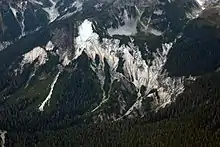Kulshan Caldera
The Kulshan Caldera is a Pleistocene volcano in the North Cascades of Washington and one of the few true calderas identified in the entire Cascade Range.[1]

Formation of the caldera about 1.5 million years ago was accompanied by the largest eruption in the history of the Mount Baker volcanic field when ice covered much of the region around Mount Baker. More than 12 cu mi (50 km3) of rhyodacite magma exploded from a shallow magma chamber and filled the caldera and surrounding valleys with ignimbrite. Subsequent glacial erosion removed most of the tephra fallout near the source of the eruption, leaving behind a 1 ft (0.30 m) thick tephra deposit preserved 125 mi (201 km) south of the caldera. The eruption that created the caldera was comparable in volume to the one that produced Crater Lake in Oregon.[2]
Between 1.15 and 0.99 million years ago, dike-fed eruptions produced rhyodacitic lava domes and lava flows inside the caldera. Another volcanic phase 1.1 to 0.5 million years ago emplaced over 60 andesite dikes, the eruptive products of which have since been stripped away by glacial erosion. It is speculated that the eruptive rocks from this volcanic phase formed a large andesitic cone now completely removed.[2]
References
- Harris, Stephen L. (1988). Fire Mountains of the West: The Cascade and Mono Lake Volcanoes. Missoula, Montana: Mountain Press Publishing Company. p. 534. ISBN 978-0-87842-220-3.
- "The Eruption History of Mount Baker". United States Geological Survey. 2013-10-01. Retrieved 2019-04-19.
![]()